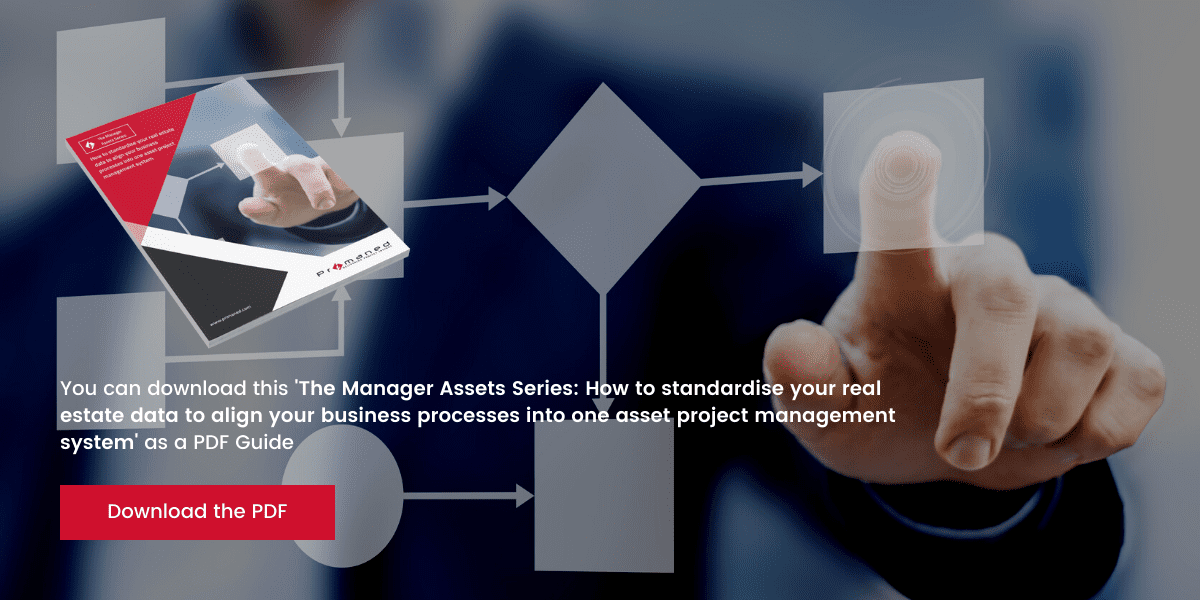The Manager Assets Series: How to standardise your real estate data to align your business processes into one asset project management system
By Sjef van Vugt on Mar 24, 2022 11:00:00 AM
.png?width=580&height=326&name=Blog%20featured%20images%20GOOD%20(14).png)
The Manager Assets Series: How to Standardise Your Real Estate Data to Align Business Processes into One Asset Project Management System
The importance of corporate real estate, from both a financial perspective and a strategic perspective, is growing. And for many businesses, this means that the number of active projects they’re handling at any given time is not only rapidly increasing, but also becoming more and more complex and challenging.
Unfortunately, some are finding that their current processes simply aren’t robust enough to manage all of these complex projects effectively across all phases.
The State of the CREM Market
The world of corporate real estate management is changing. Following the global health crisis, CREM experts are poised to be at the forefront of commercial recovery. Today’s clients have different needs to the needs they had just a few years ago.
There’s a firmer focus on areas such as employee safety, enhanced productivity, flexibility, and affordability. At the same time, your client’s customers are placing increasing pressure on them to prioritise sustainability and social responsibility.
The CREM landscape is becoming unrecognisable. There’s more pressure on corporate real estate managers, their organisations, and their teams than ever before, which means it’s essential that processes are tightened and standardised to ensure projects can be managed in ways that drive the best possible outcomes.
To manage projects with ease and efficiency, the first starting point that every CREM must consider is data. Data is at the heart of everything, so making sure that it’s handled correctly, accessible to those who need it, and accurate is key.
And the only way for that to happen is to bring together separate data sources into a single interface. And that can be achieved with an asset project management system.
What is an Asset Project Management System?
An asset project management system is an all-in-one real estate management solution. Unlike other project management systems that may focus on risk or resource management, asset project management systems are specifically designed to help CREMs manage the entire lifecycle of real estate projects.
Real estate management solutions simplify complex projects into smart workflows, offering a wide range of modules depending on your needs, such as:
- Planning
- Estimating
- Cost controls
- Document controls
- Scheduling
- Asset management
- Workflow
All of these aspects can be managed through a single interface, intended to be easy to use by all project stakeholders, regardless of their department or skill.
There are 5 things that any good asset project management system should do:
- Help you merge your legacy asset systems into a single data source, allowing you to get rid of multiple, conflicting interfaces and work from one simple platform.
- Empower you to make smarter, better, data-driven decisions for projects using real time, up-to-date information that best meet the requirements of your clients.
- Transform complex projects into easy-to-set-up workflows that bring every stakeholder seamlessly into the process to boost collaboration and communication.
- Create complete project transparency across the wider organisation to keep everyone on the same page, reduce errors, and minimise miscommunications.
- Centralise data to build a Common Data Environment; a single source of truth that can be seen and utilised by everyone, regardless of their department.
Digitalising Corporate Real Estate
Corporate real estate management has, traditionally, relied heavily on manual processes. That’s what organisations are accustomed to. Reports show that 80% of CREM leaders are still using old, outdated legacy technologies that don’t fully support the modern workflow, and which aren’t fully equipped to handle the increasingly complex projects that today’s real estate managers are dealing with.
However, as the person in charge of managing complex projects, you know that it’s time to embrace digital transformation. The problem is, those in charge of budgets may not feel the same, and may take some convincing before they’re on board.
They see the potential of digitalisation, of course. In fact, 81% of businesses see ‘high potential’ from digital CREM systems, compared to just 19% who see ‘moderate potential’ and 0% who see no potential at all. But unfortunately, decisions aren’t just made on potential alone, but on how different people perceive digital systems.
It can be even more of a challenge when there are so many people involved in the decision making process. From directors, VPs, SVPs, and more, there can sometimes be more than 40 people that need to be convinced that digitalising corporate real estate management is worth it. It can certainly be difficult to get buy-in from all departments to adopt a single web-based real estate inventory management software system. A good way to do this is by focusing on the need for change.
Consider the underlying business reasons why going digital is a good idea…
- The shift to remote working is driving digital project management platform adoption, with a growing need for a web-based management system.
- Today’s clients expect more. If your processes are lagging behind, you’ll lose your competitive advantage, and clients could begin to look elsewhere.
- The world of CREM is changing. The global health crisis has changed the scope of projects significantly, and managers require greater support.
- Building regulations are becoming tighter. With a need to consider sustainability and energy ratings, CREM is becoming increasingly complex.
- Errors are being made. Greater project complexity combined with a lack of insights mean mistakes are happening, such as contracts not being renewed.
Quite simply, all of these changes together mean that CRE leaders cannot continue on the path they’re on. What worked yesterday isn’t going to work tomorrow. Board members and executives need to understand that shift in the landscape, and work with leaders to identify and invest in solutions that support the future of CREM.
Securing the Right Support
A significant part of getting buy-in for change is having a plan in place for how you’re going to change, what systems you’ll use to create this change, and how you’ll implement the change in a way that minimises disruption for the business.
This all comes from choosing the right partners and securing the right support.
And, unfortunately, it appears that many are making the wrong choices. In fact, one study found that only 50% of CREM businesses that have adopted digital systems believe that these systems are ‘good’ or ‘very good’ at meeting their needs. The remaining half feel that their systems are ‘unsatisfactory’ or ‘adequate. So choosing the right systems and the right support implementing these systems is crucial.
The first support partner to consider is your software provider. Many CREMs are currently working with multiple software providers, especially if they’re merging with other companies that are coming in with their own legacy systems. It can be overwhelming, and data can be spread across multiple systems which introduces a wide range of problems, from data simply being overlooked or being lost entirely.
So the first step should always be to change external vendor ownership and gain internal control of your asset data. Put yourself and your business back in the driving seat. However, there are a lot of different systems on the market today, and so many requirements that the business has. How can you identify a provider that ticks all the right boxes… one that meets 100% of your needs, not just 85% of them?
The best way is to do a little research and read some real estate management software reviews. This can help you to compare several of the most common solutions, such as Procore, Cora systems, E-builder, Ultimo, Maximo, Planon and PMWeb.
What’s right for you? The most important thing to look for in a software partner is flexibility; finding a system that enables you and your team to customise models to make them more relevant to specific projects and squeeze out the most value.
However, it’s not just a software partner that needs to be considered. It’s also important to think about finding an implementation partner, too. In fact, appointing an implementation partner is as important as choosing the real estate management solution.
If you’re feeling unsure about how to approach configuration, testing, training, and go-live, then working with a partner can be the best way to ensure a successful implementation, and successful roll out of a new process across the team.
The Benefits of an Asset Project Management System
There are a number of benefits of adopting standardised asset management processes across your organisation. Some of the biggest benefits include:
- A reduction in the amount of interfaces used. This was cited as an area where businesses could see the greatest potential according to a recent report.
- Better management of unplanned requests. Portfolio analysis in your real estate project controls process helps manage ad hoc requests easier.
- Improved experience for your client as they are able to better understand the processes you use and the guidelines under the project delivery umbrella.
- Smarter decision making from the actionable insights generated through data consolidation. Simple, single documents, not ‘Frankenstein’ reports.
- Compliance becomes easier. Facing Government audits, you can be sure you’re collecting necessary data to prove the right choices were made.
- Tasks can be completed with greater efficiency as comprehensive software removes the need for time consuming manual work through Excel or email.
- Errors are greatly reduced. When information is all over the place, reports can be very error prone. With a centralised data source, errors can be avoided.
There are also additional advantages that businesses can see when working with the *right* system, rather than just any old solution, too. Some benefits of digital real estate controls with PMWeb or other leading tools, for example, may include…
- Customisable permissions to enhance system security: Ensure that each user is only seeing data relevant to their needs, protecting the project’s privacy.
- Advanced integrations with other systems such as SAP or Oracle Finance: Allow different systems to ‘talk’ to each other for improved reporting.
- Standardised data collection and handling methods for all users: No matter how each user prefers to work, PMWeb ensures all data is handled the same.
- High functionality straight out of the box: No need to spend time customising software. Instead, it’s easy to get started instantly via simple ‘plug and play’
Ready to Get Started?
If you’re dreaming of a centralised system where clients, consultants, and contractors can all instantly see the status of a project through easy access to insights in the workflow, then it’s time to shift towards an asset project management solution. But there are a few essential prerequisites needed before diving right in.
Before getting started, there are a few business process management areas you need to investigate with an implementation partner. This can help to ensure that you’re aware of the individual challenges that lay ahead for your business, and are ready to address these challenges across all stages of the implementation process. For example, you’ll need to ensure that clients and willing to collaborate, and that contractors know what to expect when moving over to a new system.
There’s also a lot of internal pressure to implement quickly, so sorting these processes out early on can help to ensure you’re doing everything you can to digitalise corporate real estate management in a way that delivers impressive results, rapidly.
Driving Change
Is it difficult to get your team - and your business - out of their old, established processes? Sure it is. It’s tough for anyone to move out of their comfort zone. But as this guide shows, asset project management solutions can be fantastically valuable tools, so being a little aggressive - a little pushy - to help your business realise the value of such a tool is sometimes necessary.
You know what needs to be done. Now it’s time to make that happen. Don’t settle for delays in decision making, or errors in reporting. Digitalise, and standardise your real estate data for top performance.
- OPC (15)
- Software (12)
- PC Boardroom (11)
- Academy (9)
- Consultancy (7)
- Manager Project Controls (6)
- IT / Procurement (5)
- Planning Engineer / Scheduler (5)
- Project/Assets Manager (4)
- Information Manager (3)
- BI & Data Analytics (2)
- C-level (2)
- Document Controller (2)
- Document Management (2)
- Oracle Aconex (2)
- Project Controls (2)
- Risk Manager (2)
- Scheduling Lead (2)
- Operational project staff (1)
- PMWeb (1)
- Resource Manager (1)
- Safran Risk (1)
Subscribe by email
You May Also Like
These Related Stories
-1.png)
How to merge your legacy asset systems into a single data source of truth to improve project controls
How to Merge Your Legacy Asset Systems into a Single Data Source of Truth to Improve Project Controls

6 benefits of adopting standardised asset management processes across your organisation
6 Benefits of Adopting Standardised Asset Management Processes Across Your Organisation

How real estate management solutions simplify complex projects into smart workflows
How Real Estate Management Solutions Simplify Complex Projects into Smart Workflows


